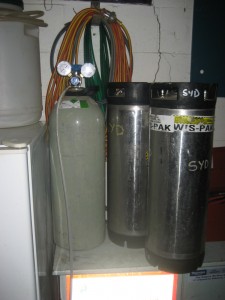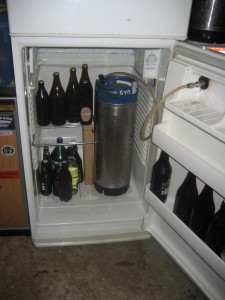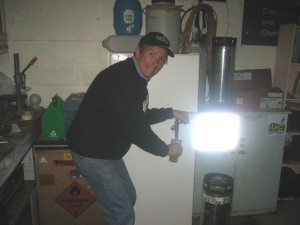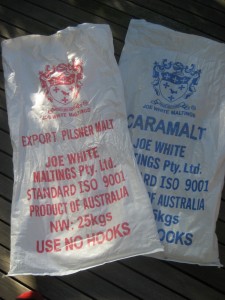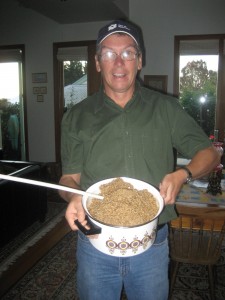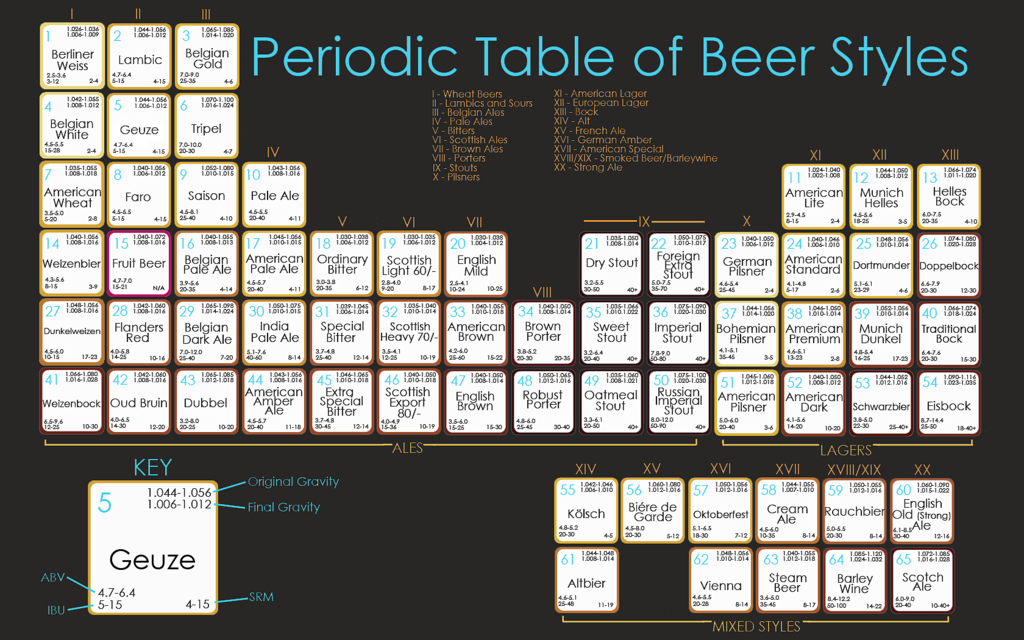Beer Brewing
All Grain beer -March 2011
Anybody can go to the supermarket, buy a can of beer conentrate and mix it up and home. But liking a challenge, and after a year of partial mash brewing, I finally made up a proper mash tun and made my first “all grain” beer. 6 kilo of barley, 4 hours of toil over a hot stove and triple hopped and I have made my first pale ale. I hope to try and replicate this beer on a regular basis. Even though the first bottle is only 1 week old, I had to taste it. Mmmm! It’s already fantastic, but after a couple of more weeks to let the bittering hop mellow it should be the world’s best beer!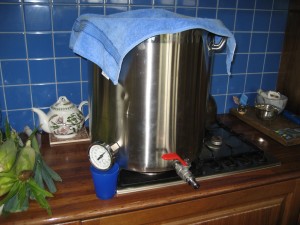
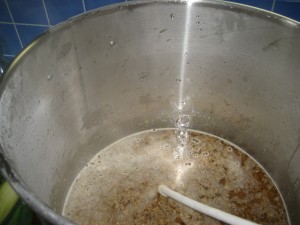
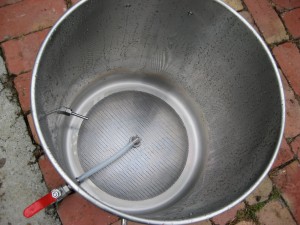
No more bottle washing! We have gone to the “CANISTER SYSTEM”!!!
July 2010. The canister system uses coca-cola drink cannisters, pressurised with a CO2 cylinder with the cannister inside the fridge, and a beer tap attached to the front of the fridge. Check the photos!
My first grain mash beer!
I was with my mate Niel from the farm the other day, and we visited his mate who runs the “red duck” brewery near Camperdown. The conversation didn’t take long to get around to beer with Niel telling Scott that I had always wanted to do a grain mash beer.
Usually I am like everyone else and just use a can of malt extract from one of the big home brewing companies like “Coopers” (Check out the Cooper’s beer web site at… http://www.coopers.com.au/) but I have done so many beers now, that I wanted to do it all by myself! So before I could even say no, Scott took us out into his brewery and like a man posessed started grabbing the ingredients I would need. Some pale malt, a little crystal malt, some hops and some other goodies. He would not even take any money for it! (What a great bloke) He put it all through his crusher so it would be ready to go when I got home.
As the grain was already crushed it had to be used quickly because it will attract moisture and not be so good after a couple of weeks. So I had to get cracking… I was a little confused by the volumes needed to produce the right volume of beer, but my calculations meant the amount of mash required would be too large for me to handle. So I had to dampen my enthusiasm, and just do a partial mash. That means still using a can of extract, but instead of adding extra fermenatables as sugars, honey etc like I always do, half the fermentable would be the grain mash. This meant 2.5 kilograms of mash had to be made. 2 kilos of the pale malt, and half of the darker crystal malt.
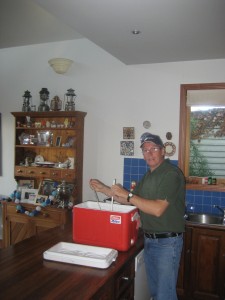
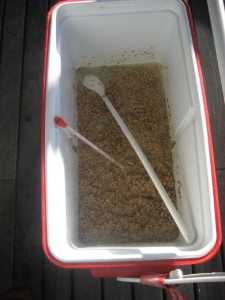 But this still makes a big volume of mash! What was I going to put it into? It either needed to be a huge pot that I could put on the stove, or as suggested on the internet, an insulated box… like my esky! So I scrubbed out the esky which still has my address in Nigeria on the lid for bringing meat home from the markets in Port Harcourt, sterilised it, and rinsed it with boiling water just to be sure. It has a little drain on the side, normally to let the melted ice out, but this time I will use it to get the wort out of this improvised “mash tun”.
But this still makes a big volume of mash! What was I going to put it into? It either needed to be a huge pot that I could put on the stove, or as suggested on the internet, an insulated box… like my esky! So I scrubbed out the esky which still has my address in Nigeria on the lid for bringing meat home from the markets in Port Harcourt, sterilised it, and rinsed it with boiling water just to be sure. It has a little drain on the side, normally to let the melted ice out, but this time I will use it to get the wort out of this improvised “mash tun”.
Enzyme theory
From the best way I can understand it, the barley is a little store house of starch, locked away in a cupboard inside the grain by the proteins. When activated, they open the starch cupboard for use when the barley is germinating. In the malting process, the grain is warmed and wetted down to make it think it’s time to grow. So the proteins open the cupboard doors giving access to the starch. Once this happens, we kill the proteins in the grain by heating and drying, and if you like darker beers, we can even toast the grain a little or a lot depending on how you like it. That’s malted barley!
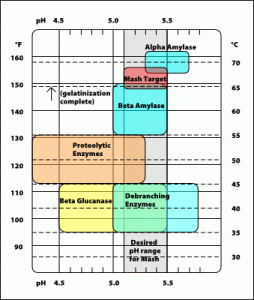 Now it’s our turn. Inside the grain, just dying to get to those starches are 5 different enzymes. Their job is to convert the starches (long complex carbohydrates) into short easy eating sugars that the plant will use to grow. We are going to use these enzymes to work for us. They are activated at different temperatures with the cooler ones changing the starch to dextrin. Although a sugar, it is still difficult for our friend the yeasty beaties to eat this. So we want to go for a higher range where the enzyme that wakes up in the high 60’s will convert the starch to maltose. This is the yeast favourite! Easy to digest converting the sugar in the maltose to ethanol (alcohol) by adding an oxygen molecule and farting out carbon dioxide.
Now it’s our turn. Inside the grain, just dying to get to those starches are 5 different enzymes. Their job is to convert the starches (long complex carbohydrates) into short easy eating sugars that the plant will use to grow. We are going to use these enzymes to work for us. They are activated at different temperatures with the cooler ones changing the starch to dextrin. Although a sugar, it is still difficult for our friend the yeasty beaties to eat this. So we want to go for a higher range where the enzyme that wakes up in the high 60’s will convert the starch to maltose. This is the yeast favourite! Easy to digest converting the sugar in the maltose to ethanol (alcohol) by adding an oxygen molecule and farting out carbon dioxide.
Then there is the pH factor. It all works best with a pH around 5.5 and the addition of the darker malted barley helps pull down the pH to this level. That is why in Dublin Ireland where the water has loads of natural alkilinity, it is ideally suited to brewing very dark beers like Guiness, while the Czech Republic has very pure water which makes it ideal for brewing lighter pilsener style beers. Fascinating isn’t it????
Let’s get on with it!
Enough of the theory, our plan was to soak the barley in water at 66 degC for 45 minutes, then go to 77 degC for another 15 minutes. Unfortunately, we didn’t get to our target, with our first reading at 62 degrees. Near enough though. I added some boiling water after 20 minutes and brought it back to 65 degC. After 50 minutes from the start, I added another 2 litres of boiling water, but failed to get 77 degrees, instead I only got 68 degrees. Never mind… I cant add any more water because I will not be able to contain the volume in my brew pot after the rinsing water is added.
Now the fun starts… I do not have a big strainer even though I search the kitchen shops all over Geelong trying to find a really big one, I had to make do with what I had. (Still looking for next time!) I opened my outlet drain valve which immediately became plugged with the poridge from inside. Swishing around with my big spoon and we got her flowing again. It took ages, with spillage of the sticky stuff etc… not the most fun you can have. Luckily I had another of my earlier beers close by to give me hope …gulp gulp… 🙂
After experimenting with some new swear words, I finally had the grain separated from the wort and rinsed which filled the 2 biggest pots from the kitchen cupboards, and as I poured myself another beer, which proudly as the beer pots began to boil on the stove. Time to chuck in the hops. Because this was a partial mash brew, there is some hops already in the extract tin, but another 20 gms of hops was added to the boiling pots which was left to bubble away for 20 minutes before being cooled in the laundry sink with some iced water.
Into the fermenter next with some yeast nutrient, some floculant to help the grain particles to settle to the bottom, and topped up with some cooled water to give 22 degrees. Now to see how well we did… I measured the specific gravity and got 1046. A little short of our target, but not too bad for my first try.
Latest update…
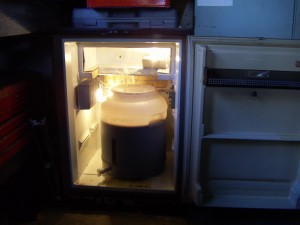
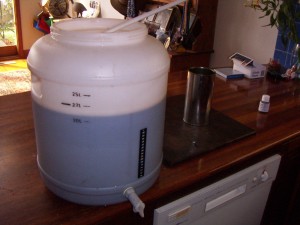 Today the fermenter stopped bubbling and the final specific gravity was 1016. This will calculate to an alcohol content of 4.5% which is a little less than my normal brews but still ok. I hope it tastes as good as all the effort that when to make it! I shall bottle it over the coming weekend. Happy Drinking! Mark 🙂
Today the fermenter stopped bubbling and the final specific gravity was 1016. This will calculate to an alcohol content of 4.5% which is a little less than my normal brews but still ok. I hope it tastes as good as all the effort that when to make it! I shall bottle it over the coming weekend. Happy Drinking! Mark 🙂
********************&&&&&&&&*********************&&&&&&&&**********************
Why Homebrew?
 I started home brewing after living in England and Africa with lots of British expats who gave me the taste for British style beers. Tetley, John Smith’s, Newcastle Brown, and my favourite from Scotland, McEwan’s Export Lager!
I started home brewing after living in England and Africa with lots of British expats who gave me the taste for British style beers. Tetley, John Smith’s, Newcastle Brown, and my favourite from Scotland, McEwan’s Export Lager!
So when I returned home and found that buying imported English beer was too expensive, I started to make my own. It takes some practise and experience, but it’s worth persisting and I never would have dreamed that I could make beer that friends prefer to drink rather than the ones they bring to my BBQ’s or boat cruises. (Maybe they are just tight?)
As time goes by, I find myself brewing Australian style beers, and it often happens that the cheaper brews I make turn out better than some of the fancy expensive ones I try occasionally in my search for something different. Gone are the days when a bloke drank Melbourne Bitter all his life and would never dream about the blasphomy of trying to drink another type of beer. And those trips inter-state where you had to drink NSW beer… I mean what do they know about brewing??? At least we don’t have to drink the world’s worst beers from South Australia which is the state where even the potable water tastes like seawater and every house has a rainwater tank.
At least my Mum likes to drink my beer! She will probably kill me for posting such a flattering photo!
Get it down ya Gran!!!
…and now here is the expert on drinking beer! See the clip below, this bloke is a legend!
Thank you Petri in Sweden for this scientific explaination…

